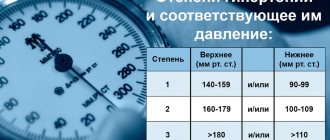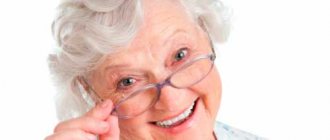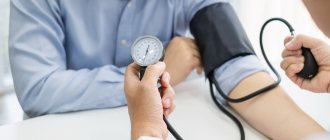15 minutes
1454 views
Hypertension is a condition of the body in which the blood vessels constantly experience increased blood pressure: systolic blood pressure equals or exceeds 140 mm Hg and/or diastolic blood pressure equals or exceeds 90 mm Hg.
The diagnosis of “hypertension” is made in cases where, according to pressure measurements taken on two different days, the value of systolic pressure on both days is equal to or exceeds 140 mmHg. Art. and/or the diastolic pressure value on both days is equal to or greater than 90 mmHg. Art.
The danger of this condition is the risk of damage to the heart or blood vessels in other organs, such as the brain and kidneys.
Uncontrolled hypertension can lead to heart attack, enlarged heart, and eventually heart failure. Blood vessels can develop dilations (aneurysms) and develop vulnerable spots where the vessels are more likely to become clogged and rupture. Pressure in the blood vessels can lead to bleeding in the brain and stroke. Hypertension can also lead to kidney failure, blindness, and cognitive impairment.
Hypertension is called the “silent killer”. Most patients with hypertension are not even aware of the problem, since hypertension often does not give warning signs and is asymptomatic.
We invite everyone to use the Cardiac Diagnostics medical program to assess the condition of your cardiovascular system and receive advice from all the necessary specialists.
Risk factors for developing hypertension
Stress, mental and mental fatigue
Research shows that hypertension is more common in people whose life is associated with constant nervous tension. For example, in residents of large cities, hypertension is much more common than in people living in rural areas.
Hypertension and stress are inextricably linked, so it is necessary to treat both ailments.
Every fourth man and every fifth woman in the world has high blood pressure
Research shows that hypertension is more common in people whose life is associated with constant nervous tension. For example, in residents of large cities, hypertension is much more common than in people living in rural areas. Hypertension and stress are inextricably linked, so it is necessary to treat both ailments.
Complications of hypertension are responsible for 9.4 million annual deaths worldwide (WHO)
Physical inactivity
Physical inactivity is a decrease in muscle load due to a sedentary lifestyle. A modern city dweller does little physical labor, prefers to use vehicles even for short distances, instead of walking, and spends his free time in front of the computer or TV. Only 1% engage in recreational sports and 5% do morning exercises.
As a consequence, this lifestyle leads to significant changes in all life-supporting systems of the body, especially the cardiovascular and nervous systems.
The combination of physical inactivity and stress makes a person extremely vulnerable to hypertension and its complications. Adrenaline produced during times of stress stimulates the production of glucocorticoids, which, in turn, stimulate an increase in blood sugar and an increase in blood pressure.
In an immobilized body, adrenaline and sugar, instead of “burning out” with the release of energy, remain in the blood vessels for a long time and lead not only to a long-term increase in pressure, but also to heart attacks and strokes.
Overweight
In order to determine whether you are overweight or not, body mass index is used. It is calculated as the ratio of body weight in kilograms to the square of height in meters. If the result obtained exceeds 25 kg/sq.m for young people and 27 kg/sq.m for older people, but does not exceed 30 kg/sq.m, then this means that there is excess weight. If the index value is above 30 kg/sq.m, then in this case we are talking about clinically pronounced obesity.
More than half of patients with hypertension are obese.
Obesity is a chronic metabolic disease in which excess fat accumulates in adipose tissue.
Numerous scientific studies have proven that reducing excess fat mass by 5-10% leads to a decrease in high blood pressure and improved control of the disease.
Other risk factors
Unhealthy diet - excessive salt intake, high content of saturated fats and trans fats in food, insufficient consumption of vegetables and fruits. As well as the use of tobacco and alcohol.
Uncontrollable risk factors include family history, age, and underlying medical conditions such as diabetes or kidney disease.
Prevention of arterial hypertension
Path to page: Home For the population Prevention of diseases and healthy lifestyle Prevention of non-communicable diseases Prevention of arterial hypertensionPrevention of arterial hypertension
Arterial hypertension is defined as an increase in blood pressure above 140 and 90 mmHg. Art. If left untreated, hypertension leads to an increased risk of coronary heart disease, stroke, kidney damage, and increased overall mortality.
Hypertension, like any chronic progressive disease, is easier to prevent than to treat. Therefore, the prevention of hypertension, especially for people with a family history, is an urgent task.
First of all, everyone whose blood pressure is within the high or borderline norm should think about the prevention of hypertension, especially for young people and adolescents
Prevention of arterial hypertension can be primary and secondary.
Primary means preventing the occurrence of a disease. These prevention methods should be followed by healthy people who have a high risk of developing hypertension (heredity, work). But not only them, everyone must live in accordance with the principles of primary prevention of hypertension, because this disease often overtakes at the most unexpected moment even those who do not have unfavorable heredity and other risk factors.
Primary prevention of hypertension includes:
- Normalization of the function of the central nervous system (prevention of stress).
- A clear daily routine (constant times of getting up and going to bed).
- Outdoor exercises and physical therapy (long walks in the fresh air, cycling, moderate gardening).
- Daily loads in the gym and at home.
- Normalization of sleep (sleep up to 8 hours).
- Balanced diet. Carefully count the kilocalories consumed in food, and do not allow excessive consumption of fat. Fats can be consumed per day no more than 50–60 grams, and 2/3 of them should be fats of vegetable origin: corn, sunflower oil. Limit foods containing large amounts of animal fats - whole milk, butter, sour cream. The diet should contain a sufficient amount of proteins: low-fat fish, poultry, skim milk, cottage cheese, kefir, etc. It is necessary to limit the intake of easily digestible carbohydrates: sugar, honey, pastry products, chocolate, semolina, rice cereals.
- Weight loss (for obesity). Without weight loss, there is no need to talk about preventing hypertension. You should not try to lose weight suddenly; you can reduce body weight by 5–10% per month.
- To give up smoking!!!
- Reducing table salt consumption (consume no more than 6 grams per day).
- Consumption of foods high in potassium, calcium and magnesium salts (low-fat cottage cheese, parsley, beans, prunes, beets, baked potatoes, dried apricots, seedless raisins.)
- Limiting the consumption of alcoholic beverages.
Secondary prevention is carried out in patients in whom arterial hypertension is diagnosed. Its goal is to prevent complications from occurring. Moreover, this type of prevention includes two components: non-drug treatment of arterial hypertension and antihypertensive (drug) therapy. Non-drug treatment, in principle, corresponds to primary prevention, only with more stringent requirements. If each individual person cannot change heredity and environment, then lifestyle and nutrition can. Drug therapy is medications prescribed by a doctor that specifically act on high blood pressure, reducing it. Patients with arterial hypertension should strictly adhere to the doctor's recommendations and take medications as prescribed, thereby preventing the risk of complications.
Prevention of arterial hypertension includes systematic monitoring of blood pressure levels in the morning and evening. Consistently following the recommendations of the attending physician, promptly contacting him if the condition worsens.
Remember! It is easier (and cheaper) to prevent a disease than to treat it.
Prevention of hypertension
Every adult should monitor their blood pressure. In case of high blood pressure, you should consult a doctor.
People with high blood pressure who also have high blood sugar, high blood cholesterol or kidney problems are at increased risk of heart attack and stroke. Therefore, it is important to regularly check your blood sugar levels, blood cholesterol levels and urine protein levels.
There are a number of specific steps everyone can take to minimize the risk of developing high blood pressure and its adverse effects:
Mental balance
Mental well-being and a positive emotional state are essential conditions for maintaining health. What is especially important for patients with hypertension or predisposed to its development, because the disease is directly related to an inadequate response to stress.
It is necessary to learn how to manage stress in healthy ways such as meditation, various types of psychotherapy and positive social contacts.
Specialists of the Peredelkino Cardiological Sanatorium Center: neurologists, psychotherapists, cardiologists will give you comprehensive recommendations and teach you how to resist stress.
Walking in the fairytale forest surrounding the sanatorium and active recreation in nature will give you a good boost of energy. Getting to know the local attractions will give you peace of mind.
Physical activity
The second component of the prevention of hypertension is sufficient physical activity, without which we all suffer to varying degrees from manifestations of physical inactivity.
For a city dweller, it would be optimal to walk for at least 1 hour every day in a forested area.
At the Peredelkino Cardiological Sanatorium Center, as part of the Cardioprevention program, dosed walking classes are held in Meshchersky Park, mechanical therapy in the gym, group water aerobics in the pool, and city sports competitions are held.
Patients with an already manifested disease should engage in physical therapy.
It is necessary to adhere to a regime of rational alternation of work and rest. Overwork of any type, both mental and physical, should not be allowed. Healthy physiological sleep is of great importance, during which the body rests from all stress. Patients at the initial stage of hypertension should sleep at least 8-9 hours a day.
Healthy eating
In the prevention of hypertension, proper nutrition or diet in clinically pronounced forms of the disease is of great importance.
Carbohydrates
Here you should give preference to vegetables and fruits, as this will allow you to get a sufficient amount of fiber, vitamins and minerals.
Squirrels
When choosing proteins, you should avoid or limit meat products in favor of dairy and plant-based ones.
Fats
Total fat intake should be reduced. Try to replace animal fats with vegetable fats, and among animal fats there should be more fish fats.
A diet with limited salt can be a cure for patients with hypertension. No more than 5 g (slightly less than one teaspoon) is allowed per day, which makes control over blood pressure levels much easier.
Maintain a normal weight
Reducing excess weight or treating obesity is the main factor that can lead to satisfactory control of blood pressure and even, in some cases, abandon drug correction of the latter.
An effective means for normalizing weight is diet therapy and various types of physical activity.
Rejection of bad habits
If a person is prone to drinking alcohol in large doses or smoking, then the risk of hypertension increases many times over.
Alcohol intake promotes spasm of peripheral vessels and increased blood pressure due to increased vascular resistance.
After smoking, cholesterol levels increase, which is due to the release of large amounts of adrenaline and norepinephrine from the adrenal glands. There is even such a medical term - nicotine hypertension.
Preventing hypertension is a top priority for many people. Knowledge about measures to prevent this serious illness is especially relevant for patients with a family history and people whose blood pressure levels are within the borderline or high norm.
In this article we will tell you who is at risk for developing hypertension, as well as measures to prevent the disease.
Who is at risk
The risk group includes:
- men 35-50 years old;
- women after menopause;
- women taking estrogen-containing drugs;
- persons experiencing constant stressful situations;
- patients with cerebral atherosclerosis, cardiovascular diseases, kidney pathologies and diabetes mellitus;
- patients with high blood cholesterol levels;
- smokers;
- persons who frequently drink strong alcoholic drinks.
Hypertension deserves close and constant attention from both doctors and patients, since it can significantly worsen the quality of life and lead to the development of severe complications.
A sharp rise in blood pressure can provoke:
- severe headaches,
- significant decrease in performance,
- atherosclerosis of the arteries of the brain, kidneys and heart.
Subsequently, such disturbances in the structure and functioning of blood vessels lead to the development of hypertensive encephalopathy, aneurysms and aortic dissection, malignant hypertension, retinopathy and heart failure. However, it is possible to solve this problem with the help of constant prevention of hypertension, which involves the implementation of a number of primary and secondary measures.
Primary prevention of hypertension
Primary prevention of hypertension is indicated for all people (especially those at risk) whose blood pressure is within the acceptable range (up to 140/90 mm Hg) and the disease has not yet begun to develop.
To do this, they need to reconsider their entire habitual way of life and make the necessary amendments to it, for example, the following:
To give up smoking.
Limiting the consumption of alcoholic beverages (for men - no more than 30 ml of strong alcoholic drinks per day, for women - no more than 20 ml).
Reducing salt intake (no more than 5-6 g per day).
Rational nutrition (limiting the consumption of foods with a large amount of animal fats, no more than 50-60 g per day, and easily digestible carbohydrates).
Inclusion in the daily diet of foods rich in potassium, magnesium and calcium (dried apricots, prunes, raisins, baked potatoes, beans, parsley, low-fat cottage cheese, chicken egg yolks).
Combating physical inactivity (exercises in the fresh air and daily physical therapy exercises).
Fighting obesity (trying to lose weight dramatically is not recommended: you can reduce body weight by no more than 5-10% per month).
Normalization of sleep patterns (at least 8 hours a day).
A clear daily routine with a constant time of getting up and going to bed.
Stress prevention.
Recommendations for the primary prevention of arterial hypertension include:
timely and regular treatment of diseases of the cardiovascular, nervous, urinary and endocrine systems,
strict adherence to all doctor’s recommendations,
constant monitoring of blood pressure levels.
Persons for whom primary prevention of hypertension is indicated should be under clinical supervision.
The measures taken can lead to a stable normalization of blood pressure within 6-12 months, but when observing indicators in the border zone, they may be recommended for longer observation and taking medications, the action of which is aimed at reducing the progression of neurotic reactions (hypnotics, sedatives, bromine and phenobarbital in small doses).
Secondary prevention of hypertension
Secondary prevention of hypertension is indicated for patients in whom arterial hypertension has been diagnosed.
It is aimed at:
decreased blood pressure;
prevention of hypertensive crises;
prevention of secondary changes in organs and the development of complications.
The range of such events includes:
- non-drug treatment (more stringent measures corresponding to primary prevention);
- drug therapy.
For non-drug treatment, in addition to following the recommendations for the primary prevention of hypertension, as well as in the complex of measures, it is recommended to include:
physiotherapeutic procedures: electrosleep, electrophoresis with drugs (aminophylline, nicotinic acid, no-shpa), galvanization of the collar zone, balneotherapy (carbon dioxide, iodide-bromine and radon baths), heliotherapy, speleotherapy, hydrokinesitherapy, massage, acupuncture, laser puncture;
physical therapy;
psychotherapeutic trainings and auto-trainings;
sanatorium-resort treatment in local cardiological sanatoriums and climatic resorts (Nemirov, Mirgorod, Kislovodsk, Truskavets, Druskininkai, Sochi, etc.).
Drug therapy is prescribed to all patients with a persistent increase in blood pressure (if blood pressure remains consistently high, up to 140 mm Hg, for three months) and patients with some risks of developing cardiovascular diseases.
The selection of drugs, their dosage, regimen and duration of administration are determined individually for each patient, based on data on his state of health. The course of taking medications for hypertension should be carried out constantly and under the supervision of the attending physician.
Comprehensive measures to prevent hypertension allow you to keep arterial hypertension under constant control and significantly reduce the risk of developing various severe complications.
Source: https://doctor-cardiologist.ru/
Read also:
- How to avoid a stroke
- Pain in the heart area
- Risk factors for stroke. Everyone should know this
- Urgent self-help and mutual aid measures
- 20 facts about the human heart
- Learning to measure blood pressure correctly
- Why is hypertension dangerous?
- Stop thrombosis, save lives
- WHO. Prevention of heart attacks and strokes
- How to recognize a stroke in time
- Hypertension is an epidemic of the 21st century. Questions and answers
- Sick heart: hidden signs
- Arterial hypertension - basic concepts
- World Hypertension Day
- September 29 – World Heart Day
- Want a healthy heart? Move more!
- VTsIOM: about a third of Russians lead a lifestyle that contributes to the development of stroke
- A third of Russians over 18 are at risk for stroke
- WHO. Global recommendations on physical activity for health
- Stroke. The diagnosis will be made by a doctor
- Stroke. The result is worth the effort
- Cholesterol: what is it?
- How to prevent cardiovascular accident
- Doctors have identified the main cause of death in Crimea
Physical methods for preventing the development and exacerbations of hypertension
Hydrotherapy
Hydrotherapy (hydrotherapy) is a powerful means of recovery, prevention and treatment of hypertension. Water can affect the body as a temperature, mechanical or chemical irritant, and the choice depends on the need for one or another factor of influence.
The temperature factor is the most important in choosing a hydrotherapy technique. Skin capillaries expand and contract in response to exposure to water of varying temperatures. In this case, either an increase in blood flow or a decrease in it occurs. Cold water also slows and increases heart rate and increases blood pressure. Hot water lowers blood pressure, speeds up the heart rate and weakens heart contractions
Most often, to prevent exacerbations of hypertension, water at an indifferent temperature is used, which is indicated for excessive nervous excitability, irritability, cardiac dysfunction, and insomnia.
Hydrotherapy procedures are contraindicated for stage III hypertension.
Before using water procedures as a treatment, you should consult your doctor.
For hypertension stages I-II, rain, dust and circular showers are used using indifferent or warm water with moderate pressure from water jets.
Baths can be general and local; in case of hypertension they are used for therapeutic and preventive purposes. Medicinal baths for hypertension are limited to the use of pine extract.
You can see about the types of hydrotherapy at the Peredelkino Cultural Center here
Drug electrophoresis
This is the use of galvanic current for the purpose of interstitial non-invasive administration of various drugs. Under the influence of galvanic current, drug ions enter the skin and are retained under the anode area, which creates a kind of drug depot. The drug enters the bloodstream rather slowly, which increases the duration of its effect on the body. The body is also affected by the positive effects of galvanic current.
Electrophoresis is indicated in the initial stages of hypertension. At stage III, it is contraindicated. In addition, contraindications are neoplasms, acute inflammatory processes of any location, disorders of blood clotting processes, pronounced atherosclerosis, decompensated diseases of the cardiovascular system, kidneys, pregnancy, individual intolerance to galvanic current.
At the Peredelkino Cultural Center, various types of physiotherapy are used. More details can be found here
Therapeutic exercise (physical therapy)
Therapeutic exercise is used at all stages of hypertension to prevent hypertensive crises and complications of the disease. It includes any available types of physical exercise - dosed walking, morning exercises, health path, swimming.
The best way of prevention is morning exercises or exercises, which allows you to prepare the body for a working day, stimulates the processes of nervous regulation of blood circulation and the reactivity of the vascular system as a whole.
If the disease has already developed, then you should add a daily complex of therapeutic exercises to the morning exercises.
At the Peredelkino Sports and Fitness Center, individual and group physical therapy classes are conducted under the guidance of professional exercise therapy instructors.
Drug therapy
The selection of medications for the treatment and prevention of exacerbations of hypertension should be carried out only by a doctor.
Drug therapy becomes necessary already at the second stage of the disease, when blood pressure reaches significant levels with regular measurements.
The main principle is the individual selection of antihypertensive drugs for each patient.
Dear readers, the articles are for informational purposes only. Before using the recommendations, you should consult your doctor.
Hypertension: causes and prevention
Hypertension is characterized by increased blood pressure in the arteries compared to normal. In a healthy person, normal blood pressure is approximately 120/80 mmHg. Some people have low blood pressure (100/70) or high blood pressure (over 140/90). The upper pressure reading (systolic pressure) corresponds to the contraction of the heart walls, the lower reading (diastolic pressure) corresponds to the relaxation of the heart walls. Risk of hypertension
Hypertension today is a widespread disease that is typical for residents of highly developed countries.
In Russia, hypertension occurs in every third person. In addition, at present, this disease is rapidly becoming younger, and today hypertension can be found in adolescents. The main danger of hypertension is that high blood pressure can cause ruptures of blood vessels in the heart, brain, eyes, kidneys, and lead to premature death. Untreated hypertension shortens life. Symptoms of high blood pressure:
headache;
dizziness. the appearance of “flies” before the eyes; noise in ears; pain in the heart area; strong heartbeat In some cases, hypertension is asymptomatic. This disease is called the “silent killer.” Physical causes
At the physical level, the development of hypertension is caused by a reduction in the lumen of blood vessels due to atherosclerosis.
Due to the narrowing of blood vessels, blood flow is impeded. In order to push blood through the narrowed bloodstream, the heart makes more effort. At the same time, blood pressure on the walls of blood vessels increases, which causes an increase in blood pressure. Psychosomatic causes
Hypertension is a psychosomatic disease.
Blood pressure reflects the degree and nature of a person’s activity, his attitude to various events, and to obstacles along the path of life. Increased blood pressure is a person’s reaction to certain events in life. Those people who have been experiencing internal tension and resistance for a long time, generated by all kinds of fears, mistrust, and unwillingness to accept a particular situation, increase their blood pressure. A person experiences pressure from troubles that he cannot cope with at the moment. Thus, the psychological cause of hypertension is a person’s tendency to dramatize a situation: to worry about past events and worry about future affairs. Such a person wants those around him to be happy and takes on too much responsibility. Thus, he puts strong pressure on himself, which leads to an increase in internal tension and an increase in blood pressure. Treatment of hypertension
Treatment of psychosomatic diseases should be carried out comprehensively: both at the physical and psychological levels.
It is important not only to get rid of high blood pressure as a consequence of the disease, but also to eliminate the cause of its occurrence. And the reasons are most often emotional. Drug treatment
In the drug treatment of hypertension, several groups of drugs are used: drugs to lower blood pressure (there are 5 groups of such drugs);
vasodilators; sedatives. The selection of medications is strictly individual for each patient and is carried out by the attending physician based on an analysis of the patient’s condition, symptoms of the disease and developed complications of hypertension. Treatment with folk remedies
In addition to drug treatment, you can use folk remedies.
Herbal medicine (herbal treatment) can be of great help. Mostly sedative herbs are used, which have a calming effect. These include hawthorn, valerian, chamomile, peppermint, and lemon balm. Honey, citrus fruits, rose hips and green tea are used to reduce blood pressure. For people with hypertension, special diets are selected that involve reducing salt in food and reducing fluid intake. People with hypertension are prohibited from drinking alcohol. Psychological treatment
For a person with high blood pressure, it is advisable to give up the pursuit of the approval of others, and learn to live simply and love people.
The authors of books on self-healing suggest using the following positive attitudes: “I am calm and healthy,” “There is peace in my soul,” “I am in harmony with life.” Prevention of hypertension Hypertension
cannot be prevented by a one-time vaccination or a one-time preventive measure.
In order to prevent the development of hypertension, it is necessary to constantly maintain a healthy lifestyle and a balanced diet. Tips for preserving and maintaining health:
Exercise regularly to keep blood vessels in good shape. Maintain a normal weight, since obesity can lead not only to hypertension, but also to coronary heart disease. Stop smoking, as nicotine constricts blood vessels. After hard work, mandatory rest is necessary. At the same time, active rest is recommended for mental workers, and for people whose work involves physical activity, rest in a quiet environment is suitable. Take blood tests for sugar and blood lipids (cholesterol, triglycerides) twice a year. Measure your blood pressure regularly. Periodically undergo an ECG of the heart. Remember that preventive measures, as well as timely and correct diagnosis, will prevent the development of a serious disease.
Deputy Chief Physician for Medical Affairs
OGAUZ "Angarsk City Hospital No. 1"
Protasova V.A.
Section: Diseases of the cardiovascular system










